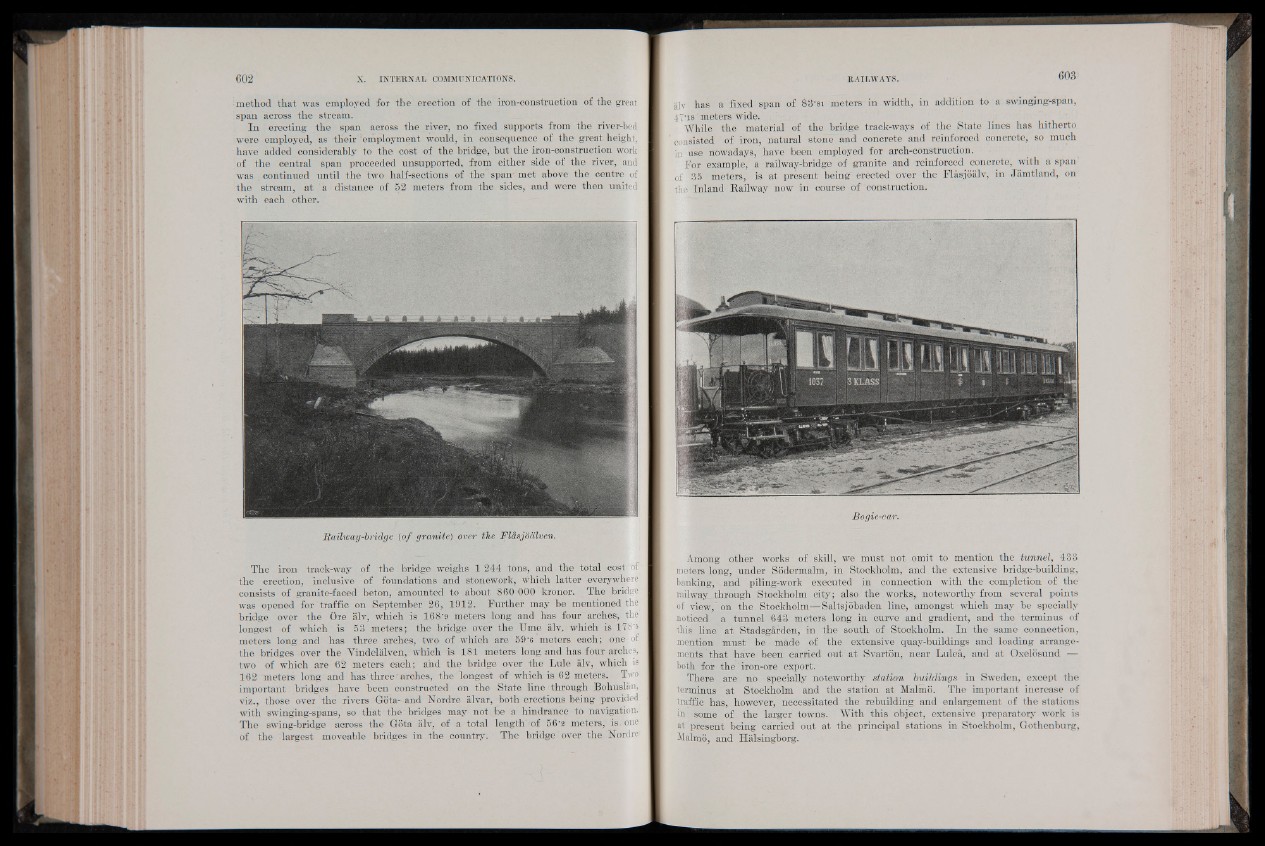
method that was employed for the erection of the iron-construction of the great
span across the stream.
In erecting the span across the river, no fixed supports from the river-bed
were employed, as their 'employment would, in consequence of the great height,
have added considerably to the cost of the bridge, but the iron-construction work
of the central span proceeded unsupported, from either side of the river, and
was continued until the two half-sections of the span' met above the centre of
the stream, at a distance of 52 meters from the sides, and were then united
with each other.
Railieay-bridge (o f granite) over the Flàsjoàlven.
The iron track-way of the bridge weighs 1 244 tons, and the total eosjj of
the erection, inclusive of foundations and stonework, which latter everywhere
consists of granite-faced beton, amounted to about 860 000 kronor. The bridge
was opened for traffic on September 26, 1912. Further may be mentioned;,the
bridge over the Ore alv, which is 168*9 meters long and has four arches, the
longest of which is 53 meters; the bridge over the Ume alv, which is lff8*6
meters long and has three arches, two of which are 59'6 meters each; one of
the bridges over the Vindelalven, which is 181 meters long and has four arches,
two of which are 62 meters each; and the bridge over the Lule alv, which is
162 meters long and has three'arches, the longest of which is 62 meters. Two
important bridges have been constructed on the State line'through Bohuslan,
viz., those over the rivers Gota-and Nordre alvar, both erections being provided
with swinging-spans, so that the bridges may not be a hindrance to navigation.
The swing-bridge across the Gota alv, of a total length of 56*2 meters, is. one
of the largest moveable bridges in the country. The bridge over the. Nordre.
alv has a fixed span of 83'si meters in width, in addition to a swinging-span,
47-is' meters wide.
While the material of the bridge track-ways of the State lines has hitherto
consisted of iron, natural stone " and concrete and reinforced concrete, so much
in use nowadays, have been employed for arch-construction.
For example, a railway-bridge of granite and reinforced concrete, with a span
of 35 meters, is at present being erected over the Flasjoalv, in Jamtland, on
the Inland Railway now in course of construction.
Among other works of skill, we must not omit to mention the tunnel, 433
meters long, under Sodermalm, in Stockholm, and the extensive bridge-building,
banking, and piling-work executed in connection with the completion of the
railway through Stockholm city; also the works, noteworthy from several points
of view, on the Stockholm—Saltsjobaden line, amongst which may be specially
noticed a tunnel 643 meters long in curve and gradient, and the terminus of
this line at Stadsgarden, in the south of Stockholm. In the same connection,
mention must be made of the extensive quay-buildings and loading arrangements
that have been carried out at Svarton, near Lulea, and at. Oxelosund —
both for the iron-ore export.
There are no specially noteworthy station buildings in Sweden, except the
terminus at Stockholm and the station at Malmo. The important increase of
traffic has, however, necessitated the rebuilding and enlargement of the stations
in some of the larger towns. With this object, extensive preparatory work is
at present being carried out at the principal stations in Stockholm, Gothenburg,
Malmo, and Halsingborg.